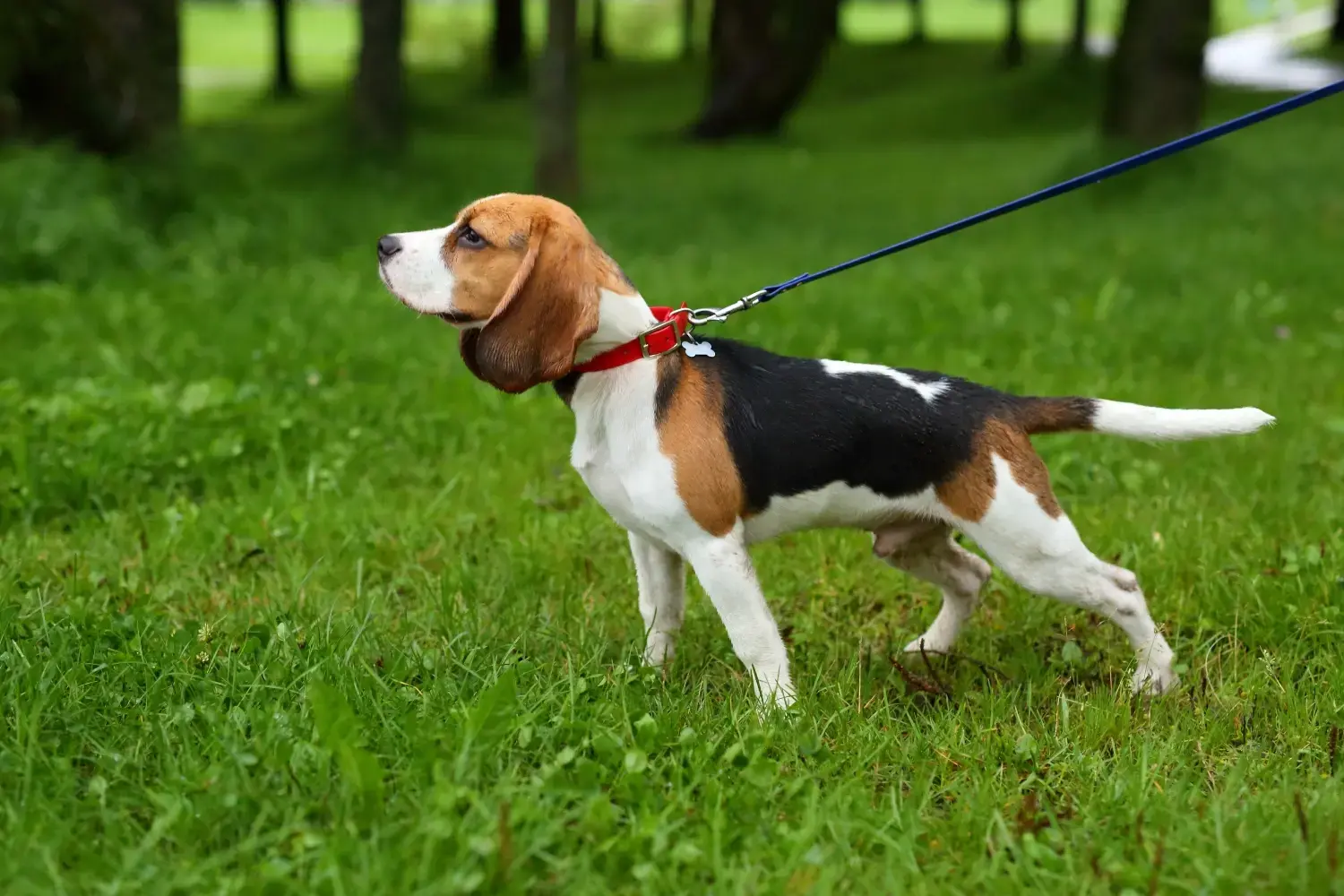
Do your daily dog walks involve being pulled down the street by your over-excited pooch? Are you sick of hearing your dog wheeze and cough while choking himself with his collar? Learn how to stop your dog from pulling on leash!
Your daily walk with your dog should be a relaxing and enjoyable experience, but if you have an overly excited dog, your walk could quickly turn into a frustrating and stressful activity that plays out like a tug of war.
Learn how to stop dog from pulling on leash, and start enjoying your walks again with these dog training tips for good leash manners.
Are you ready to learn how to train a dog to stop pulling on leash?
Pulling on Leash is Common, But Not Good
Your doggo is over the moon excited for every outdoor adventure. It's hard to blame them for wanting to follow their nose and run free, but good walking behaviours make walks safer and more enjoyable for both of you.
If they've never been taught a better way using sound dog training, walking, and obedience techniques, most dogs will continue to pull to the end of their rope... and yours.
This poor walking behaviour is more than just irritating; it can be dangerous too. When dogs pull, they cough, they wheeze, and they pant like crazy, all because they are so excited to explore, but the reality is that they can be hurting themselves.
Teaching your dog to heel appropriately takes time and perseverance, but trust us, having your canine companion strolling beside you while the leash remains loose is worth it. Your daily walks quickly become something that you look forward to once your dog stops pulling and walks beside you nicely.
In the end, you will have a happier, healthier, better-behaved dog who stops pulling due to positive reinforcement.
We connected with a local St. Albert-based training company, Nurtured K9, to get some helpful tips for getting started so your dog learns to stop leash pulling and walk perfectly beside you.
They offered some excellent advice on walking aids, common mistakes, dealing with distractions, and how to stop leash pulling.
How to Train a Dog Not to Pull on Leash
When learning to train your dog not to tug on a leash, you'll also need to teach yourself a few tricks. It takes mental prowess to remain calm during the training process.
When you have a young and rambunctious pup who you are just starting to train, you might find yourself growing frustrated when your dog tries to drag you down the road.
Discovering how to stop a puppy from pulling on leash is not always straightforward, and teaching better behaviours will take time.
What works for one pup might not work for another if the young dog is headstrong. You'll need to explore various dog training methods to find one that is successful for both you and your dog.
A dog pulling on a leash is frustrating. You probably feel like you are being walked instead of the other way around. Just take a few deep breaths and focus on how to stop dog from pulling on leash without losing your cool.
Remember, your young dog just needs to learn the ropes, and then the pup will walk on the leash like a pro.
Choosing the Right Tools for Walking
Before you start, you need to ensure you have the best tools to help you achieve your goals and begin walking your furry friend. Every dog is sized and shaped differently, so your walking accessories may vary depending on how they fit your furry friend.
There are a few different types of walking aids that can help. What you choose depends on your dog's shape and behaviour. Avoid using a choke chain, prong collar or electronic collars, which can make a dog pull harder and make them more fearful.
Harnesses can reduce the pressure and stress placed on your dog's neck, while a collar will prevent chafing and pressure on their shoulders.
A collar should still be worn to display their tags, but these walking aids can be effective if you choose the right style for your pooch. A no-pull harness is designed specifically to train dogs to walk nicely on a leash.
You can choose from a few different styles of walking accessories, each with its pros and cons. Many dogs respond to one or more of the gear listed below.
1. Back-Hook Harnesses
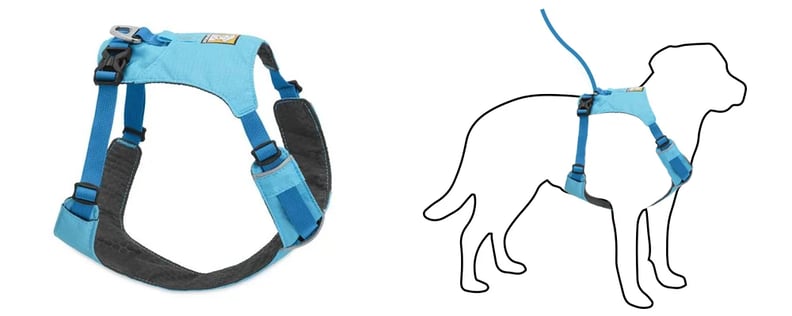
This style is the most common harness on the market. They are simple to use and available in many different styles to accommodate different-sized dogs. Choose the style that fits most comfortably on your dog.
| Pros | Cons |
| Ideal for casual walking - Does not place pressure on the neck | Doesn't deter pulling |
| Easy to put on with a secure chest strap | Can provide strong pullers with more leverage to pull |
| Affordable | Poor-fitting harnesses can still put pressure on your dog's neck |
2. Front-Clip Harnesses
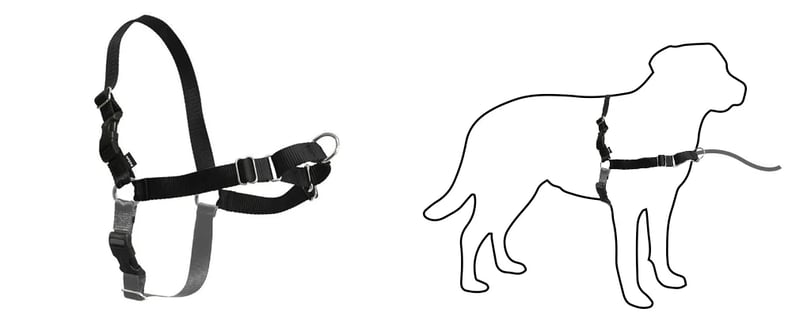
If your dog is strong and consistently pulls, a front clip-style harness will be more effective. The leash will attach at the center of the front of the dog's chest and hang to their side, forcing them to turn whenever they pull, promoting good behaviour.
| Pros | Cons |
| Guides the direction of your dog by turning them | Not suited to every style of dog |
| Sits low on their chest, away from their neck | Causes chaffing in armpits if not sized properly |
| Most styles tighten slightly to further deter pulling | Can be more expensive |
3. Head Collars
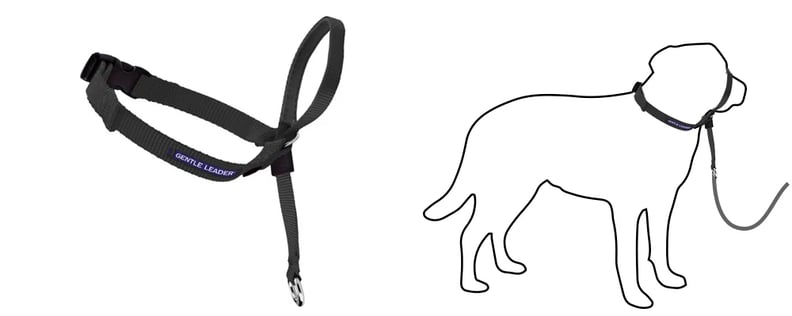
Head collars are the third style. This option is one of the popular training tools that appeal to some dog owners. Head collars work by directing the dog's head in whatever direction you desire, allowing you to break their line of sight from whatever they are pulling towards.
| Pros | Cons |
| Guides head to redirect concentration | Requires more training to allow your dog to adapt |
| Eliminates pressure on the neck and chaffing from harnesses | Can be harmful if used improperly |
| Limits dog's ability to pull from their center of gravity | Can be uncomfortable with certain facial shapes |
| Affordable | Limited styles and availabilities |
4. Two-Touch Harnesses
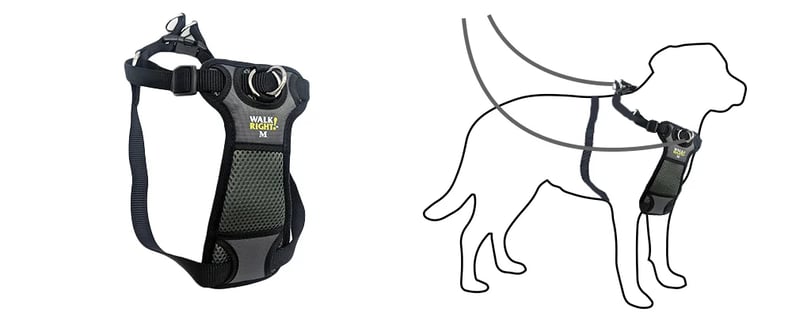
A two-touch harness has both a front and a back clip. Using a coupler, or a double-ended leash, you can attach your leash to both clips giving you the benefits and security of both styles of harnesses. The chest-led harness is easy to place on your canine and helps dogs learn quickly not to pull.
| Pros | Cons |
| Provides the most control and security | Multiple accessories make it more expensive |
| Most effective styles for discouraging pulling | Few options and limited availability |
| Multi-purpose harness for different situations | More work to put on/take off |
5. Slip-Lead
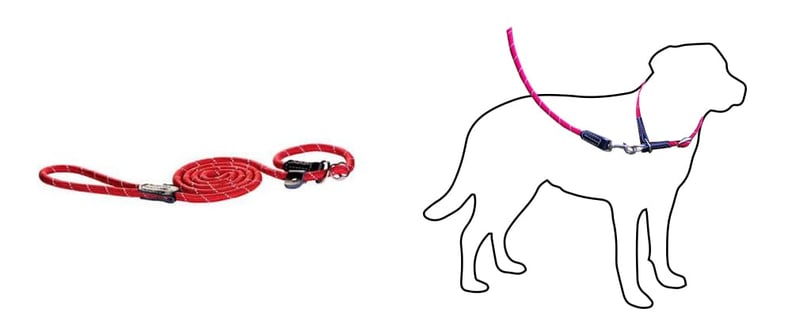
A slip lead is a collar and leash as a single unit, and a tool that is often recommended by professional trainers.
Tips From an Expert:
According to the team at Nurtured K9, slip leads are a good way to teach your dog the concept of pressure on and pressure off.
When they pull, they will feel pressure. When they relax or slow down, the pressure will be alleviated. This technique allows you to reward or praise as your dog puts the pieces together.
A dog trainer will often tell you that harnesses can cause damage to your pup's shoulders, especially with strong pullers. The constant turning and jerking can damage over time and chafe the skin around their front legs and chest.
You might want to forego a harness and use a collar on the dog's neck to achieve good behaviour if your dog's harness is causing discomfort.
| Pros | Cons |
| Easy to use and put on | Puts pressure on the neck |
| Reduces chaffing from harness rubbing | Few options and limited availability |
| Inescapable | Handle grip can be uncomfortable |
6. Leashes
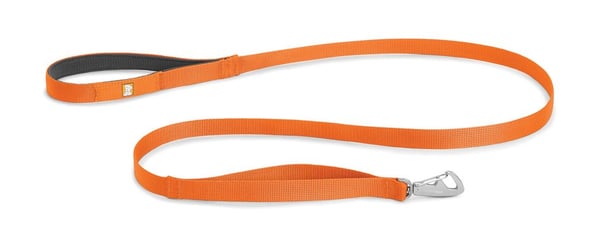
The type of dog leash you choose will depend on where and how you are training. When asking yourself how to stop my dog from pulling on leash, it's important to remember that the leash you choose can have an effect on your training.
A common mistake when teaching proper walk etiquette is using a retractable leash. This style is not ideal for teaching boundaries and will not help you when trying to train loose leash walking.
Tips From an Expert:
It's best to invest in a standard 4-6 ft lead, according to the Nurtured K9 team. This will allow you to set a firm boundary for your dog. You want them to know how far ahead of you they are allowed to walk, giving you more control when you come across a fun distraction.
Another option that is effective for this type of training is a hands-free dog leash that clips to your belt loop. This style may come with a belt or may convert to allow you to wear the leash as a belt or sash.
Having the leash as your center of gravity will give you more leverage if you need to stop or change directions, so it's great for owners of large breeds or very strong dogs.
Choosing the Right Environment for Training
Dogs are easily distracted, excited, and spooked, so choosing a suitable environment to train in can make or break your training experience. Your dog's ability to focus on instructions can be the difference between a productive and positive experience and a frustrating or stressful one.
Pick an enclosed space that is free of distractions, such as other animals, when teaching dogs loose leash walking.
All training needs to be done in manageable steps, so pick an environment that suits your dog's level of attention and experience.
Tips From an Expert:
Nurtured K9 recommends working on obedience in a low-distraction setting. You want to be the most important thing to your dog, and everything on the walks should be neutral to them unless a cue is given to interact.
Once the obedience is perfect in low-distraction settings, you can start to add small distractions at a distance. Treat while you approach these distractions to associate them with a reward.
Choosing times and places that won't overwhelm your dog is best until your dog has had some practice. Jumping right into a busy walking path or a packed dog park, your dog will have a very hard time staying focused on you and what you are trying to teach.
Steps to Loose Leash Training

Loose leash training takes time and repetition, so don't try to rush the process. The more time you spend on each step, the easier it will be for those lessons to sink in. Your dog pulling on leash is annoying! In time, you can bring back the joy of taking a long walk with your dog.
Step 1: Gear Up
Putting on your dog's gear can send them into a fit of excitement. Before leaving the house, gear up your dog and ask for simple commands, like sit, shake, or lie down. Set the precedent that this is a training session by asking a few simple commands and rewarding them. This way, your dog will be actively engaged as you begin to train new commands
Step 2: Go to a Training Space
Move to your backyard, driveway, or another familiar but secluded area. While holding the leash, continue to ask simple commands that your dog already knows and reward for each correct response. Remember, you are trying to get them in the mindset that you are here to train.
Step 3: The Training Process
Now that you have your dog's complete attention, use the verbal command “walk” or a similar short command that you can use consistently. Start doing small laps. If at any time your dog veers away or pulls too far ahead of you, immediately stop the walk.
Don't jerk on the leash or pull your dog back; Stop and prevent your dog from moving forward. Call your dog back to your side and ask for a sit. Once your dog has calmed down, start your lap using the same verbal command you started with.
The “follow me” game is another method of getting your dog to look at you when they stop listening. This is a great way to reconnect with your dog when they are refusing to respond to your vocal commands. When they pull, say, “Follow me,” turn and start to move in the other direction. You don't have to go too far, just far enough to get your dog to follow you.
Do this each time your dog pulls. This will teach him that pulling will not get him what he wants. It will also teach him that you are in control of the walk, where you go, and how fast.
Step 4: Repeat, Repeat, Repeat
Don't dismiss the value of repetition. The more you do it, the better your dog will listen to your commands. This may be all you do for the first several training sessions, but in the long run, it will pay off.
Step 5: Advance Slowly
As your dog's training progresses, you can start bringing your dog to larger, more open, and busier areas. Try to find a quiet path or a small park that will provide a few minor distractions to test out your dog's focus.
Things may quickly deteriorate as you add distractions, so remain the pack leader and stay consistent and positive. Always focus on repeat behaviours so your dog pays close attention to your actions.
Step 6: Maintain Consistency
Once your dog demonstrates that they can keep focused and wait for your direction, you are ready to try a more heavily populated area, like a pet store 😉. There may be missteps after each transition or new situation, so make sure you continue using the same language and praises to direct and reward your pup.
Step 7: Big Distractions
Some things will trigger a nervous or skittish canine more than others. Machinery, bicycles, and skateboards could easily break your dog's focus on you and lead to unwanted, reactive, or unexpected behaviours.
Tips From an Expert:
Nurtured K9 recommends feeding constantly while passing these distractions. If you see a car or bicyclist, continue to feed small treats until it passes. This will start rewiring their brains to have a positive association with the trigger.
Step 8: Ask for Help When a Dog Pulls
Sometimes even the best laid plans fall apart. If you find that you are getting too frustrated with slow results or that your dog is just not interested in the process, then it's time to bring in a pro at training dogs to help you with dog walking.
Connect with Nurtured K9 on Instagram to learn more!
Troubleshooting Tips: Leash Walking
Most dog training requires patience and repetition, but if you feel like you are hitting a wall when teaching your dog loose leash walking, then we have some out-of-the-box methods that might be right for your dog.
Below are a few troubleshooting tips that teach how to successfully stop dog from pulling on leash.
Conquering a Determined Puller
When learning how to prevent leash pulling, you must accept that every dog has its own unique personality traits. Some will master walking on a leash quickly, and others will become an even greater challenge.
If your pup is a determined puller, you might need to tackle the problem differently. Here are some alternative approaches to handling exceptionally stubborn dogs that pull on leash.
The minute your dog starts to pull on the leash, you need to instantly stop the leash training exercise and walk away. Don't communicate with the dog or even take the time to acknowledge the pup's presence. Instead, just walk away.
Your dog knows he is supposed to stay with you and will eventually catch up to you. When your dog is finally beside you again, acknowledge his presence and show that you are happy to see him. You might even want to offer him a reward for catching up to you and striding alongside.
Eventually, your dog will start to learn to pay attention to you and stop pulling on the leash because his action of pulling gets him nowhere.
Your Pup Fails to Respond to Any of Your Tricks
Is your frustration building when it comes to how to get your dog to stop pulling on leash? If so, then you'll need to evaluate the equipment you are using to train the dog to walk on a leash without pulling.
Sometimes the fix is as simple as swapping out a collar for a head halter, which will give you greater control over your persistent canine puller.
If you have switched out all the current training equipment for new items to teach your dog not to pull on a leash, but the animal is still straining with every walk, then you might want to explore your training tactics.
Maybe you need to take a refresher obedience class to learn new tricks. You might even want to invest in a few private lessons with a skilled and qualified instructor. Also, you might find an article helpful that is filled with helpful assistance is a benefit.
Weaving and Circling
Puppies and older dogs often learn the trick of running circles around you (you become tangled in the leash) or weaving. Both are annoying behaviours that can prove dangerous because you can easily trip over the leash.
To overcome the problem, lure your pup beside you using a tasty morsel of food. Once the dog is beside you, walk forward a few steps holding the food. When your dog stays by your side for a short distance, reward him with a treat, even when you reverse direction.
Provide High-Value Treats
Do you feel frustrated because you have tried everything, but your dog is still pulling on the leash? If so, then you might have to offer high-value dog treats.
Some dogs are picky and won't work without extreme motivation. You'll need to find a tasty morsel that your dog absolutely loves or one that grabs the canine's attention. Treats are one method that is always highly successful when it comes to training.
Overcoming High Prey Drives
Dog breeds with a high prey drive often have problems when they start walking on a loose leash. The pooch will see a squirrel and instantly start to react by lunging full force at the end of the leash.
Other dogs simply do not act properly when they begin walking near smaller dogs or other triggers that ignite the animal's natural instincts to chase.
You'll want to watch your dog's body language. Two dogs together can increase the prey drive in your dog and the other dog, so pay close attention to your pup's actions.
Once you familiarize yourself with your dog's prey drive triggers, you'll need to avoid them. Especially during training sessions because you don't want your puppy's attention to stray from the task at hand.
As your dog more firmly grasps the concept of walking on a leash, you can start taking the dog around things that might elicit a prey-drive response.
However, when successfully training a dog to walk on a loose leash, remember that all the processes take time and patience. When learning how to prevent leash pulling, you'll need to familiarize yourself with your dog's triggers to avoid them initially.
Keep Them Guessing
Your dog probably looks forward to going for a walk. If you are like most pet owners, you take your pup for a stroll around the neighbourhood. Your canine companion has an excellent sense of direction and probably knows the route you take well.
In fact, your dog probably knows exactly where you are going to head when you go for a walk, so immediately starts pulling you along. Who is taking who for a walk?
At this point, you are probably tired of struggling with your dog pulling incessantly on the end of the leash. A trick to overcome excited pulling is to keep your dog guessing.
Keeping your dog guessing which way you will turn or what direction you will ultimately go is a wonderful way to overcome unwanted, excited pulling. Your dog will learn to pay attention to you.
One Paw in Front of the Other

Eventually, your dog will be able to give you a loose leash while passing trees, people, other dogs, and even wildlife without lunging forward in excitement.
This process may be quick for some, and for others, it could take much longer than you'd like. It will depend on how consistent you are and how excitable your dog is.
The important thing to remember is that your dog reacts based on instinct, and for most dogs, that instinct is “OMG! This is my favourite thing ever!!” Even if it's the same tree or neighbour, you walk by daily.
Frequently Asked Questions About Loose-Leash Walking
Why does my dog struggle on the leash, and how can I prevent it?
Dogs often lunge on the leash due to excitement, lack of training, or a desire to explore. To prevent pulling, consistent leash training, using positive reinforcement, and teaching your dog loose leash walk techniques can be effective.
How can I teach my dog to walk on a loose leash?
Start by using a properly fitting or front-clip harness that discourages pulling. Practice taking your dog for a stroll in a controlled environment, rewarding your dog for strolling beside you without tension on the leash. Gradually increase distractions and reinforce good behaviour
Should I use a specific type of leash?
Using a standard 4-6-foot leash and a harness (such as a front-clip or no-pull harness) can help discourage pulling.
What techniques can I use to discourage pulling during walks?
Try using positive reinforcement, rewarding your dog for strolling calmly beside you. Stop moving when your dog pulls and only resume when there is slack on the leash.
How can I manage my dog's excitement during walks?
Exercise your dog before walks to reduce excess energy and excitement.
Can professional training or assistance be beneficial for leash pulling?
Yes, professional training can be highly beneficial, especially if you're struggling to address the issue on your own. Check out Nurtured K9 in Edmonton for more information.
.png?width=200&height=66&name=logo%20(1).png)


.jpg)
